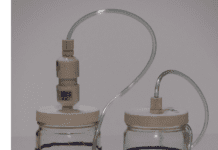I want to varnish my companionway hatch boards, but I need to remove the old finish. Is there a varnish remover that works well and doesn’t ruin the wood?
Simon Zorovich
PoleStar, Beneteau 44.7
Depending on what type of finish is already on the wood, a chemical stripper may not be the best tool for the job, especially for a comparably small, flat project like hatch boards. Strippers are usually a last resort when a finish is too hard or too tenacious for other removal methods. It is the messiest and most potentially hazardous way to take down varnish.
Most wood finishes—teak treatments, stains, and one-part varnishes—can be removed by sanding with an electric or pneumatic orbital, dry-scraping with a cabinet scraper, or using a heat gun and a pull scraper. However, there are times when a chemical stripper is the way to go—like removing varnish from a louvered door or trying to remove harder, epoxy-type finishes. Oftentimes, strippers are used as a second step, to get the varnish off that sanding and scraping could not. Some two-part varnishes may require such aggressive heating-scraping that we’d recommend using a combination of manpower and chemical power to get the job done without damaging the wood.
For your project, we’d recommend electric sanding or heat-and-scrape. But if the old finish is too hard for sanding and you choose to use a stripper, steer clear of any containing methylene chloride, a highly toxic chemical found in many hardware-store strippers that is a known carcinogen. Instead, choose a friendlier product like Franmar’s Soy-Strip or Dumond’s Peel Away Smart Strip.
SoyStrip (www.franmar.com) is a mildly aggressive, soybean-based stripper that has done well in our past tests of bottom paint strippers (PS, November 2006) and in more recent exterior-wood-stripping projects. Soy Strip uses a powerful organic solvent that has a comparatively low toxicity.
Peel Away Smart Strip, made by Dumond Chemicals (www.dumondchemicals.com), is another biodegradable, water-based stripper that has done well in past tests (PS, April 2008).
For taking off super-stubborn wood finishes, we’ve used the aggressive Interlux’s Interstrip 299E (www.yachtpaint.com), but it should be used with extreme caution as it can damage gelcoat. We’ve also known other boat owners who have had good success with CitriStrip (www.citristrip.com), but we’ve not yet tested it.
If you can take the boards off the boat to strip them, do it. If not, then be sure to tape off the project area and cover adjacent areas with sheet plastic as strippers will also remove paint and damage gelcoat. And be sure to don safety gear (eye protection, neoprene gloves, long sleeves, and a respirator), even when using eco-friendly strippers.
Strippers soften varnish by saturating it with solvents. You can boost stripper performance by first sanding the surface with 80-grit sandpaper, making it easier for the product to penetrate and soften the varnish. Finishing pros like Rebecca Wittman (author of “Brightwork: the Art of Finishing Wood”) recommend layering it on, covering it for 15-30 minutes, and then brushing away the released varnish with a toothbrush. Others, like author Don Casey (“Sailboat Refinishing”), suggest brushing the stripper on, letting it dwell, then gently scraping it off with a wide putty knife, and scrubbing the wood with bronze wool. Multiple applications may be required to take the old finish all the way down, especially if there are lots of coats.
Stripper should be applied in short strokes, not brushed back and forth. The more you brush the product on, the more vapors escape into the air, and the vapors are doing the work, so fewer vapors means slower stripping. Afterward, be sure to thoroughly clean the stripped surface with denatured alcohol or lacquer thinner. Any remaining residue will cause adhesion problems for the new varnish. Vacuum up the debris, then freshwater wash the wood, and lightly scrub it with a soft brush. This neutralizes the stripper and also raises the grain, a good prep for sanding.
No matter the stripping method or product you use, the waste will be toxic and must be disposed of according to local laws for toxic waste.


































